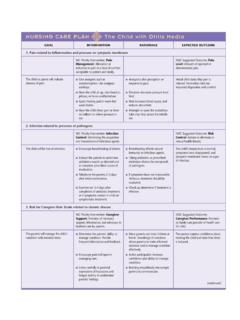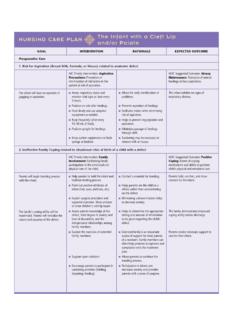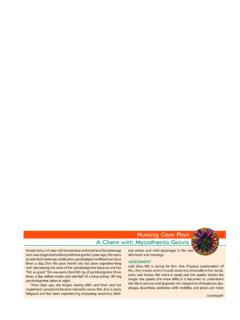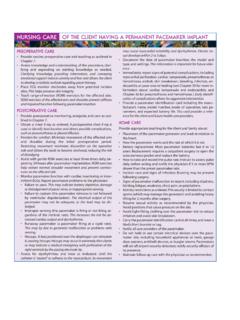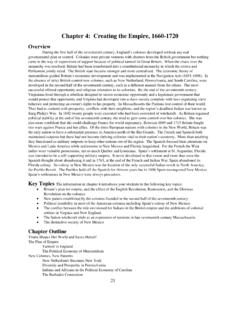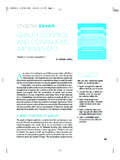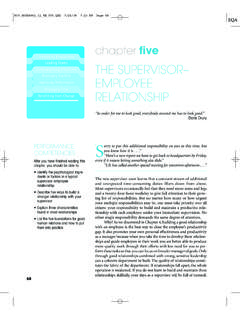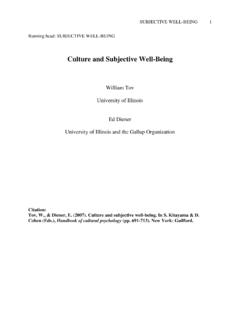Transcription of CHAPTER 1 - WHAT IS MORALITY - Pearson Education
1 CHAPTER 1 - what IS MORALITY ? General Overview: The objectives of this first CHAPTER are to introduce the core terms and ideas of MORALITY , distinguish MORALITY from other closely related areas and then move towards a basic working definition of MORALITY . Most students will have had little real exposure to these concepts so carefully organizing and presenting the material here will enable students to begin to build a picture' of philosophical ethics for themselves. Class Suggestions: In those first humbling moments of class you've introduced yourself and established your right' to speak. Perhaps before a thorough review of your syllabus and an ethics icebreaker you might give a general introduction to the course.
2 Students will want to know how this class will be of interest and relevance to them. You can explain this best by tying the objectives of the course to a current example of a moral issue. The newspapers are full of these examples every day. There will be many current examples of moral issues that relate directly to their major and their lives. In fact this would tie in to a first homework assignment: tell them to find a current topic or issue that interests them in the news and tell them to be prepared next class to explain why it is a moral' issue, asking them to think also about the pros and cons of the issue and perhaps offer a view on it. Having explained the relevance of ethics through a current example you might then begin to introduce some of the key terms, concepts and questions for this CHAPTER found in the next section of this handbook.
3 Towards the end of the first class I would have students in pairs doing a basic questionnaire on what makes something moral to prepare them for the homework assignment and next class. 1. CHAPTER 1 - what IS MORALITY ? Key Concepts: Philosophy, Ethics, MORALITY , Good, Bad, Right, Wrong, Hedonism, Happiness, Pleasure, Excellence, Harmony, Creativity, Amoral, Non moral, Descriptive ethics, Normative ethics, Metaethics, Values, Subjective, Objective, Situational, Custom, Tradition, Law, Religion. Key questions: 1. what is the relation between philosophy and MORALITY ? 2. what is MORALITY ? 3. what are the different approaches to MORALITY ? 4. How does MORALITY differ from aesthetics, etiquette, law, religion or custom?
4 5. Where does MORALITY come from? 6. Why should you be moral? CHAPTER Summary what is philosophy and ethics' relationship to it? Philosophy philia/sophia -means love' or friend' of wisdom. Philosophers try to be a friend of wisdom by asking questions and studying why something is the case. Ethics seeks wisdom by asking about right and wrong, good and bad. Terms and characteristics. Ethics comes from the Greek ethos meaning character. MORALITY derives from the Latin moralis meaning customs or manners. Commonly we speak of people being ethical or moral to mean good or right and unethical and immoral to mean wrong or bad. Philosophical ethics is the study of what makes something moral or ethical, good or right, and unethical or immoral bad or wrong.
5 Philosophers have considered what makes something morally good or bad, right or wrong in relation to a range of characteristics. For example, does moral goodness involve some relation to happiness or pleasure? Does the good involve excellence of some sort? Or harmony and creativity? Is it possible to be amoral of being indifferent to right and wrong? what things are non moral? For example, my pen that I write with appears neither moral or immoral in itself but if I use it as a weapon it enters the domain of MORALITY . Approaches to the study of MORALITY . There are two major approaches to the study of MORALITY : 1. The scientific or descriptive approach emphasizes the observation of human behavior and the positing of conclusions based on those observations.
6 Psychologists, for example, have claimed that human beings are basically selfish based on observations of conduct. This approach is descriptive in that it is value-free' making no judgments about the rightness or wrongness of the behavior. 2. A second approach is more properly philosophical and has two parts. a. The first part is normative or prescriptive. How should or ought we to act? b. The second part is metaethical. A metaethicist is committed to the analysis of the language, concepts reasons and foundational structure of ethical systems. Thiroux's text is committed to synthesizing all of these approaches. MORALITY and its applications. what is MORALITY ?
7 In order to further define MORALITY we need to say how it is similar to and different from other areas and non moral uses of key terms. Aesthetics. Ethics like aesthetics is a part of philosophy concerned with values. Ethics differs from aesthetics in that it is concerned with moral value although moral value and aesthetic value connect and overlap. Non Moral uses of key terms. Good, bad, right and wrong are often used in a non-moral sense, , good meal, bad tooth, etc. These uses often refer to function. Aristotle argued that MORALITY is tied to the function of a human being. This should not be confused with any idea that meals or teeth are directly linked to the moral.
8 Manners or etiquette. Manners and etiquette are forms of socially acceptable and unacceptable behavior. For example, swearing or use of foul language is in most contexts considered unacceptable. However there is no 2. necessary connection between this and immorality. Of course manners and morals overlap but care is required to distinguish them when there is no obvious connection. To whom or what does MORALITY apply? MORALITY may be applied to four areas: 1. Religion. MORALITY determined by relation between human being and supernatural being. 2. Nature. MORALITY determined by relation between human being and nature. 3. Individuality. MORALITY determined by relation the individual has to him or herself.
9 4. Society. MORALITY determined by relation between human being and society. Most moral systems involve all four of these areas with one being primary. Who is morally responsible? Should only human beings be held morally responsible? Are all animals non-moral? Where does MORALITY come from? MORALITY can be considered as having a subjective or objective origin. As objective there are three possibilities for the origin of value: 1. Values are given by a supernatural being. 2. Values are part of the fabric of nature. 3. Values are part of the furniture' of the world, independently of human beings. These possible explanations of the origin of values are expressed in the supernatural theory', the theory of natural law' and objectivism'.
10 As subjective, the origin of value is related to human beings. Without human beings, subjectivist theorists argue, there would be no value. Evaluation of objective and subjective positions. Criticisms of: 1. Supernatural theories. Belief based on faith. Diversity of traditions makes it unclear what values are best and why. 2. Natural law theories. So called laws of nature' are descriptive Are there natural moral laws, , laws that are prescriptive? 3. Objectivism. Can something have a value if there is no one there to value it? 4. Subjectivism. Are values entirely subjective? Would the world have value without the presence of humans? Synthesis: values perhaps best viewed as both subjective, objective and emerging out of a context.

